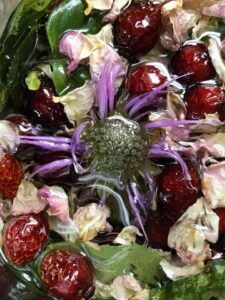Description
Ingredients
Saponified oils [locally pressed Helianthus annuus (sunflower) oil, locally pressed Brassica napus (canola) oil, Theobroma oil (cocoa butter), Cocos Nucifera (Coconut) Oil, Ricinus communis (castor) oil]; water; homegrown and wild crafted herbs; essential oils; kaolin clay.
Plant Spotlight: Bee Balm (Monarda Fistulosa)

“What’s in a name? A Rose by any other name would smell as sweet.” In her soliloquy, Juliet attempts to convince herself that names are meaningless and love is all that matters. While her view of love may be sweet (not to mention totally naive), it turns out that names really do matter. A lot, in fact! Especially in the plant world.
Botanists usually refer to a plant by its scientific Latin name. The reason is because the Latin name is universally accepted and therefore prevents the misidentification that can sometimes occur with common names. Common names on the other hand can vary by region and that can be confusing. As a kid, my cousin from West Virginia asked to pick black raspberries one summer; there was a good long minute of confusion until I finally realized she was talking about what we always called black caps. Had there only been one name, there would’ve been no confusion, but what kid is going to remember Rubus Leucodermis! While it may be less confusing to refer to a plant by its universal Latin name, it can be way more exciting to investigate all the common names for a particular plant, mainly because those names can teach us so much about that plant!
The Many Names of Bee Balm
One of the flowers used in this soap (to create the green color) is Mondarda Fistulosa. I grew up calling her “Bee Balm” but below are some of her other common names and some very cool insights we can gain from them!
OSWEGO TEA:: As a native plant in the northeast, the Oswego Nation uses the plant for both medicinal and for culinary purposes. The name “Oswego tea” stems from the Oswego nation’s use of the plant as a tea. In fact, they introduced this tea to the American colonists who drank it as substitute after tossing all the black tea into the harbor during the Boston Tea Party of 1773. Medicinally, it is helpful for digestive disorders, flatulence, respiratory ailments, mouthwash, and even headaches.

WILD OREGANO:: Try it as a pizza topping. As the name suggests, wild oregano, smells and tastes a bit similar to oregano and can be used in the same fashion. I tried it on pizza and it’s pretty good!
HORSE-BALM:: It’s antibacterial properties make it useful for treatment of skin infections and minor wounds. It kills bacteria, fungus growth, and even intestinal worms. It works great as a salve for humans, but may also have been used to treat these ailments in horses, hence the name.
WILD BERGAMOT:: The common name Bergamot is from the French “bergamote” for a type of citrus tree, named for its touch of citrus-like fragrance, and it may reflect its use as a wild, native substitute for Earl of Grey tea, which is made with the Citrus Bergamot fruit(largely unavailable to colonists).
BEE BALM:: this name reminds us that, while this plant has been used by humans for centuries, it is also adored by bees and our other winged friends as well. I actually had a hummingbird visit the patch in the photo while I was picking- along with the bees, of course.
Plant Poetry
My Neighbor Complains
My neighbor complains about his bee balm,
that scruffy plant with multiple identities:
ordinary bee balm one day, aristocratic
bergamot the next, whose oil
was favored by the umpteenth Earl of Grey.

And then there’s Oswego tea, and the name
preferred by botanists—Monarda.
It spreads too fast, he says.
It’s taking over
the garden.
Ah, but I have watched
those mop-haired clowns and
wondered if the hummingbirds love them
the way the experts say they do.
And even while wondering, even
in the act of walking by, wondering,
I’ve seen a flash and blurr,
a tiny jeweled body, wings purring;
have seen it rise from among the red
untidiness, pause,
descend again to sip,
then disappear.
Sukie Curtis





